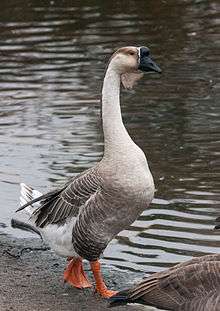African goose
The African goose is a breed of domestic goose derived from the wild swan goose (Anser cygnoides). Despite the name the African goose most likely originated in China, like the related Chinese goose. Though the African goose and Chinese goose share some characteristics (such as colour patterns), the two can be distinguished by the African's larger dewlap and different knob shape. African geese are also quite a bit heavier than Chinese, and are known for their docile temperament. Also, they lay fewer eggs than Chinese geese: 25 to 40 eggs per year for the African goose against 40 to 65, or, in extreme cases, up to 200 eggs per year for Chinese goose.

Two origin theories persist for the fowl: the first purporting that African is the result of crosses of swan goose and Chinese goose, while the other asserts that it is a direct derivation of the swan goose, and its unique traits are simply the result of selective breeding. Whichever is the case, the African goose has existed as a distinct breed since the middle of the nineteenth century or before, and was admitted to the American Poultry Association's Standard of Perfection in 1874.
Ganders often have a higher pitched call than the geese (females), and are taller, while the females are shorter and stockier, with larger keels or lobes.
African goose occurs in three color varieties: brown, buff and white. Browns have black bills and knobs, and plumage with irregular shades, from a very light to dark brown. Whites have all-white plumage and orange bills and knobs.
References
- Ekarius, Carol (2007). Storey's Illustrated Guide to Poultry Breeds. 210 MAS MoCA Way, North Adams MA 01247: Storey Publishing. ISBN 978-1-58017-667-5.CS1 maint: location (link)
- "Africans". feathersite.com. Retrieved 2008-07-02.
- American Livestock Breed Conservation Articles: Chinese Geese; African Geese